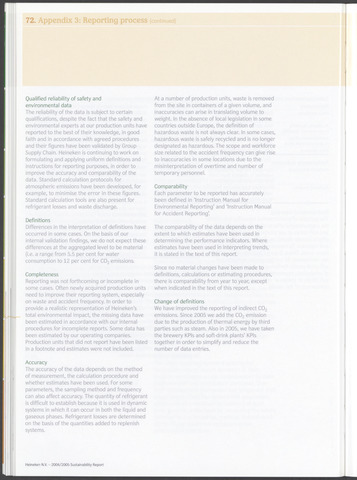72. Appendix 3: Reporting process (continued)
Qualified reliability of safety and
environmental data
The reliability of the data is subject to certain
qualifications, despite the fact that the safety and
environmental experts at our production units have
reported to the best of their knowledge, in good
faith and in accordance with agreed procedures
and their figures have been validated by Group
Supply Chain. Heineken is continuing to work on
formulating and applying uniform definitions and
instructions for reporting purposes, in order to
improve the accuracy and comparability of the
data. Standard calculation protocols for
atmospheric emissions have been developed, for
example, to minimise the error in these figures.
Standard calculation tools are also present for
refrigerant losses and waste discharge.
Definitions
Differences in the interpretation of definitions have
occurred in some cases. On the basis of our
internal validation findings, we do not expect these
differences at the aggregated level to be material
(i.e. a range from 5.5 per cent for water
consumption to 12 per cent for C02 emissions.
Completeness
Reporting was not forthcoming or incomplete in
some cases. Often newly acquired production units
need to improve their reporting system, especially
on waste and accident frequency. In order to
provide a realistic representation of Heineken's
total environmental impact, the missing data have
been estimated in accordance with our internal
procedures for incomplete reports. Some data has
been estimated by our operating companies.
Production units that did not report have been listed
in a footnote and estimates were not included.
At a number of production units, waste is removed
from the site in containers of a given volume, and
inaccuracies can arise in translating volume to
weight. In the absence of local legislation in some
countries outside Europe, the definition of
hazardous waste is not always clear. In some cases,
hazardous waste is safely recycled and is no longer
designated as hazardous. The scope and workforce
size related to the accident frequency can give rise
to inaccuracies in some locations due to the
misinterpretation of overtime and number of
temporary personnel.
Comparability
Each parameter to be reported has accurately
been defined in 'Instruction Manual for
Environmental Reporting' and 'Instruction Manual
for Accident Reporting'.
The comparability of the data depends on the
extent to which estimates have been used in
determining the performance indicators. Where
estimates have been used in interpreting trends,
it is stated in the text of this report.
Since no material changes have been made to
definitions, calculations or estimating procedures,
there is comparability from year to year, except
when indicated in the text of this report.
Change of definitions
We have improved the reporting of indirect C02
emissions. Since 2005 we add the C02 emission
due to the production of thermal energy by third
parties such as steam. Also in 2005, we have taken
the brewery KPIs and soft-drink plants' KPIs
together in order to simplify and reduce the
number of data entries.
Accuracy
The accuracy of the data depends on the method
of measurement, the calculation procedure and
whether estimates have been used. For some
parameters, the sampling method and frequency
can also affect accuracy. The quantity of refrigerant
is difficult to establish because it is used in dynamic
systems in which it can occur in both the liquid and
gaseous phases. Refrigerant losses are determined
on the basis of the quantities added to replenish
systems.
Heineken N.V. - 2004/2005 Sustainability Report

